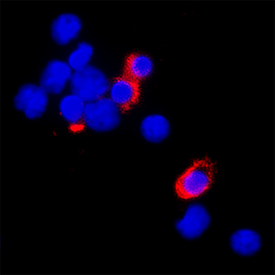Human Siglec-2/CD22 LlaMABodyTM Bivalent VHH HuIgG2 Fusion Antibody
Human Siglec-2/CD22 LlaMABodyTM Bivalent VHH HuIgG2 Fusion Antibody Summary
| Human Siglec-2/CD22 Specific Llama VHH domain | Llama Hinge | Human IgG2 |
| N-terminus | C-terminus | |
Asp20-Arg687
Accession # CAA42006.1
Applications
Please Note: Optimal dilutions should be determined by each laboratory for each application. General Protocols are available in the Technical Information section on our website.
Scientific Data
 View Larger
View Larger
Siglec‑2/CD22 in Human PBMCs. Siglec‑2/CD22 was detected in immersion fixed human peripheral blood mononuclear cells (PBMCs) using Llama Anti-Human Siglec‑2/CD22 LlaMABodyTM Bivalent VHH HuIgG2 Fusion Monoclonal Antibody (Catalog # LMAB107321) at 8 µg/mL for 3 hours at room temperature. Cells were stained using Anti-alpaca Alexa Fluor 594 (red) and counterstained with DAPI (blue). Specific staining was localized to cytoplasm. Staining was performed using our protocol for Fluorescent ICC Staining of Non-adherent Cells.
 View Larger
View Larger
Siglec‑2/CD22 in Human Tonsil. Siglec‑2/CD22 was detected in immersion fixed paraffin-embedded sections of Human Tonsil using Llama Anti-Human Siglec‑2/CD22 LlaMABodyTM Bivalent VHH HuIgG2 Fusion Monoclonal Antibody (Catalog # LMAB107321) at 15 µg/mL overnight at 4 °C. Tissue was stained using anti-Llama secondaries with HRP and counterstained with hematoxylin (blue). Specific staining was localized to cytoplasm in lymphocytes. View our protocol for IHC Staining with VisUCyte HRP Polymer Detection Reagents.
Reconstitution Calculator
Preparation and Storage
- 12 months from date of receipt, -20 to -70 °C as supplied.
- 1 month, 2 to 8 °C under sterile conditions after reconstitution.
- 6 months, -20 to -70 °C under sterile conditions after reconstitution.
Background: Siglec-2/CD22
Siglecs are type I transmembrane proteins that belong to the immunoglobulin (Ig) superfamily and function as mammalian lectins (1). They are characterized by an extracellular domain consisting of various numbers of Ig domains with a conserved N-terminal V-set Ig ligand-binding domain. This binds species-specific sialic acid motifs on protein and lipid scaffolds to regulate intracellular signaling pathways (2). The cytoplasmic tail has signaling motifs, in most cases immunoreceptor tyrosine-based inhibitory motif (ITIM) (3). Human Siglec-2, also known as B cell antigen CD22 or B lymphocyte cell adhesion molecule (BL-CAM), is a B cell restricted glycoprotein that is expressed in the cytoplasm of progenitor B and pre B cells and on the surface of mature B cells. Two distinct human Siglec-2/CD22 cDNAs that arise from differential RNA processing of the same gene have been isolated. The predominant Siglec-2/CD22 beta encodes an 847 amino acid (aa) polypeptide with a hydrophobic signal peptide, an N-terminal Ig-like V type domain, six Ig-like C2 type domains, a transmembrane region and a cytoplasmic tail with 4 immunoreceptor tyrosine-based inhibition motifs (ITIMs) (4). The variant Siglec-2/CD22 alpha encodes a 647 aa polypeptide missing two Ig-like C2 type domains and has a truncated (23 aa) cytoplasmic tail (5). Mature human Siglec-2 beta consists of a 668 amino acid (aa) extracellular domain (ECD), a 19 aa transmembrane segment, and a 141 aa cytoplasmic domain. Within the ECD, human Siglec-2 shares 59% and 58% aa sequence identity with the mouse and rat Siglec-2, respectively. Siglec-2/CD22 is an adhesion molecule that preferentially binds alpha 2,6- linked sialic acid on the same (cis) or adjacent (trans) cells. Interaction of CD22 with trans ligands on opposing cells was found to be favored over the binding of ligands in cis (6). Besides its role as an adhesion molecule, Siglec-2/CD22 is a coreceptor that physically interacts with B-cell receptor (BCR) and is rapidly phosphorylated upon BCR ligation. It negatively regulates BCR signals by recruiting tyrosine phosphatase SHP-1 to its ITIMs. Phosphorylated Siglec-2/CD22 can also interact with other intracellular effector proteins such as Syk, PLC gamma, PI3 kinase and Grb-2, suggesting it may play a role in positive signaling (7-9). Another function of CD22 is that it mediates the anti-phagocytic effect of alpha 2,6-linked sialic acid, and inhibition of CD22 promotes the clearance of myelin debris, amyloid-beta oligomers and alpha -synuclein fibrils in vivo(10). CD22 also plays a role in autoimmunity and has great potential for CD22-based immunotherapeutics for the treatment of autoimmune diseases such as systemic lupus erythematosus (SLE) (11).
- Crocker, P.R. et al. (2007) Nat. Rev. Immunol. 7:255.
- Poe, J.C. and T.F. Tedder (2012) Trends Immunol. 33:413.
- Meyer, S.J. et al. (2018) Front. Immunol. 9:2820.
- Wilson, G.L et al. (1991) J. Exp. Med. 173:137.
- Stamenkovic, I. and B. Seed (1990) Nature 345:74.
- Collins, B.E. et al. (2004) Proc. Natl. Acad. Sci. 101:6104.
- Crocker, P.R. and A. Varki (2001) Immunology 103:137.
- Ravetch, J.V. and L.L. Lanier (2000) Science 290:84.
- Wienands, Y.J. et al. (1999) J. Biol. Chem. 274:18769.
- Pluvinage, J.V. et al. (2019) Nature. 5568:7751.
- Clark, E.A. et al. (2018) Front. Immunol. 9:2235.
Product Datasheets
FAQs
-
What are Camelid Antibodies?
Camelid antibodies are antibodies from the Camelidae family of mammals that include llamas, camels, and alpacas. These animals produce 2 main types of antibodies. One type of antibody camelids produce is the conventional antibody that is made up of 2 heavy chains and 2 light chains. They also produce another type of antibody that is made up of only 2 heavy chains. This is known as heavy chain IgG (hcIgG). While these antibodies do not contain the CH1 region, they retain an antigen binding domain called the VHH region. VHH antibodies, also known as single domain antibodies or Nanobodies®, contain only the VHH region from the camelid antibody.
Reviews for Human Siglec-2/CD22 LlaMABodyTM Bivalent VHH HuIgG2 Fusion Antibody
There are currently no reviews for this product. Be the first to review Human Siglec-2/CD22 LlaMABodyTM Bivalent VHH HuIgG2 Fusion Antibody and earn rewards!
Have you used Human Siglec-2/CD22 LlaMABodyTM Bivalent VHH HuIgG2 Fusion Antibody?
Submit a review and receive an Amazon gift card.
$25/€18/£15/$25CAN/¥75 Yuan/¥2500 Yen for a review with an image
$10/€7/£6/$10 CAD/¥70 Yuan/¥1110 Yen for a review without an image


